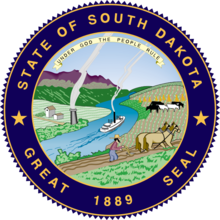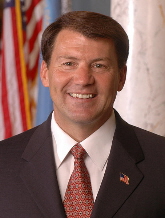Kurt Evans Redux: A History of 3rd Party South Dakota US Senate Candidacies
The Mount Rushmore State has placed only six third party or independent U.S. Senate candidates on the ballot since 1938 – by far the lowest in the Upper Midwest

Late last week, Kurt Evans announced he would again run for the U.S. Senate as a Libertarian in the high profile open seat race to replace retiring Democrat Tim Johnson.
Evans, of course, is famously known in Republican circles for “costing” John Thune a U.S. Senate seat in the 2002 election against Johnson. (Thune would return to the ballot two years later to unseat former Majority Leader Tom Daschle).
The Libertarian won less than one percent of the vote in that race, but in a contest decided by just 532 votes in Johnson’s favor, many observers believed the 3,071 votes won by Evans helped reelect Johnson. (Raising the age-old question as to whether third party candidates are bringing new voters into the electorate or changing the preference of individuals who would have voted for one of the major parties).
Evans actually dropped out of the race in mid-October just a few weeks before Election Day and endorsed Thune, but his name still appeared on the ballot and ended up receiving 0.9 percent of the vote.
The only other cycle in which another third party or independent candidate received more votes than the winning victory margin in South Dakota U.S. Senate electoral history came in 1936, when independent Arthur Bennett won 4.4 percent in a race Democratic incumbent W.J. Bulow won by 2.1 points over Republican Chandler Gurney.
Republicans are probably less worried about Evans in 2014 – a cycle in which Johnson’s seat is expected to land in the GOP’s lap, should they coalesce around a candidate that November.

A trio of GOP challengers who claim Rounds is not conservative enough have emerged in the race: State Senator Larry Rhoden, State Representative Stace Nelson, and physician Annette Bosworth.
Meanwhile, Democrats failed to land their top recruits (ex-U.S. Representative Stephanie Herseth Sandlin and U.S. Attorrney Brendan Johnson, son of Tim) and will run former Tom Daschle staffer Rick Weiland instead.
South Dakota Democrats are coming off their most embarrassing U.S. Senate race to date – in which they failed to field a candidate for the first time across the 34 general and special election contests since the passage of the 17th Amendment a century ago and a historic failure in U.S. Senate electoral history.
So, what are the odds Evans’ presence on the ballot will affect South Dakota’s Senate race in 2014?
For starters, having any third party or independent candidate on the ballot in a U.S. Senate race has been the exception not the rule in South Dakota politics over the decades.
Since 1938, non-major party candidates have appeared on the general election ballot in just five out of 27 general and special U.S. Senate elections.
Only Evans’ 2002 candidacy had any impact on the race:
· In 1998, Byron Dale won 1.4 percent of the vote in an election won by Democrat Tom Daschle by 25.7 points.
· In 1992, Libertarian Gus Hercules (1.3 percent) and independent Kent Hyde (1.3 percent) collectively won 2.6 percent of the vote in a race won by Daschle by 32.4 points.
· In 1990, independent Dean Sinclair won 2.5 percent in a contest won by Republican Larry Pressler by 7.3 points.
· In 1980, independent Wayne Peterson won 2.4 percent as Republican James Abdnor was victorious by 18.8 points.
Prior to Peterson’s candidacy in 1980 it had been 44 years since South Dakota voters had an option besides one of the two major political parties in a U.S. Senate race.
By contrast, from the state’s first popular vote U.S. Senate contest in 1914 through 1936, there were 17 third party or independent candidates on the ballot with at least one such candidate in seven of these eight cycles.
The difficulty of getting independents or third party candidates on the ballot varies from state to state and South Dakota has struggled the most among the Upper Midwestern states.
For example, from 1980 through 2012, while South Dakota only placed six non-major party candidates on the ballot, Minnesota placed 37, Wisconsin 31, Iowa 24, and North Dakota 11.
From 1938 to 2012, South Dakota again comes in at just six such candidates, with Wisconsin at 67, Minnesota at 65, Iowa at 47, and North Dakota at 31.
Since each of these state’s first direct vote U.S. Senate races a century ago, Wisconsin has placed 99 third party or independent candidates on the ballot with 84 in Minnesota, 67 in Iowa, 43 in North Dakota, and just 23 in South Dakota.
Number of Third Party and Independent U.S. Senate Candidates in Upper Midwest by State
|
State
|
1980-2012
|
1938-2012
|
1914-2012
|
|
Wisconsin
|
31
|
67
|
99
|
|
Minnesota
|
37
|
65
|
84
|
|
Iowa
|
24
|
47
|
67
|
|
North Dakota
|
11
|
31
|
43
|
|
South Dakota
|
6
|
6
|
23
|
Table compiled by Smart Politics.
However, there is some appetite for libertarianism in South Dakota.
Last cycle, Gary Johnson won 1.6 percent of the vote in the presidential race in South Dakota – his eighth best showing across the country behind New Mexico (3.6 percent), Montana (2.9 percent), Alaska (2.5 percent), Wyoming (2.1 percent), Indiana (1.9 percent), Kansas (1.8 percent), and North Dakota (1.6 percent).
The last time a non-major party candidate appeared on the ballot in a South Dakota federal statewide election was in 2010, when conservative B. Thomas Marking won six percent of the vote as Krisit Noem defeated Stephanie Herseth Sandlin to claim the state’s at-large U.S. House seat.
Marking’s tally was the best performance by an independent or third party candidate in a South Dakota U.S. House contest in more than 80 years.
The best ever showing in a South Dakota U.S. Senate race by a non-major party candidate came in 1920, when Non Partisan candidate Tom Ayres came in second with 24.1 percent of the vote, beating the Democratic nominee U.S.G. Cherry, but losing by 26.0 points to GOPer Peter Norbeck.
South Dakota Third Party and Independent U.S. Senate Candidates, 1914-2010
|
Cycle
|
Name
|
Party
|
Percent
|
|
1914
|
E. P. Johnson
|
Socialist
|
2.7
|
|
1914
|
O. W. Butterfield
|
Prohibition
|
2.4
|
|
1914
|
H. L. Loucks
|
Independent
|
2.1
|
|
1918
|
W.T. Rafferty
|
Independent
|
6.0
|
|
1920
|
Tom Ayres
|
Non partisan
|
24.1
|
|
1920
|
R. O. Richards
|
Independent
|
5.4
|
|
1920
|
L. J. Manbeck
|
Independent
|
0.4
|
|
1924
|
Tom Ayres
|
Farmer Labor
|
12.1
|
|
1924
|
George Eagan
|
Independent
|
7.2
|
|
1924
|
Charles H. Dillon
|
Independent
|
2
|
|
1924
|
H. L. Loucks
|
Independent
|
0.7
|
|
1924
|
Don Livingston
|
Independent
|
0.6
|
|
1926
|
Howard Platt
|
Farmer Labor
|
7.1
|
|
1932
|
Howard Platte
|
Liberty
|
1.4
|
|
1932
|
Oscar Luttio
|
Independent
|
0.1
|
|
1932
|
L. J. Manbeck
|
Independent
|
0.1
|
|
1936
|
Arthur Bennett
|
Independent
|
4.4
|
|
1980
|
Wayne Peterson
|
Independent
|
2.4
|
|
1990
|
Dean Sinclair
|
Independent
|
2.5
|
|
1992
|
Gus Hercules
|
Libertarian
|
1.3
|
|
1992
|
Kent Hyde
|
Independent
|
1.3
|
|
1998
|
Byron Dale
|
Libertarian
|
1.4
|
|
2002
|
Kurt Evans
|
Libertarian
|
0.9
|
Table compiled by Smart Politics.
Follow Smart Politics on Twitter.
